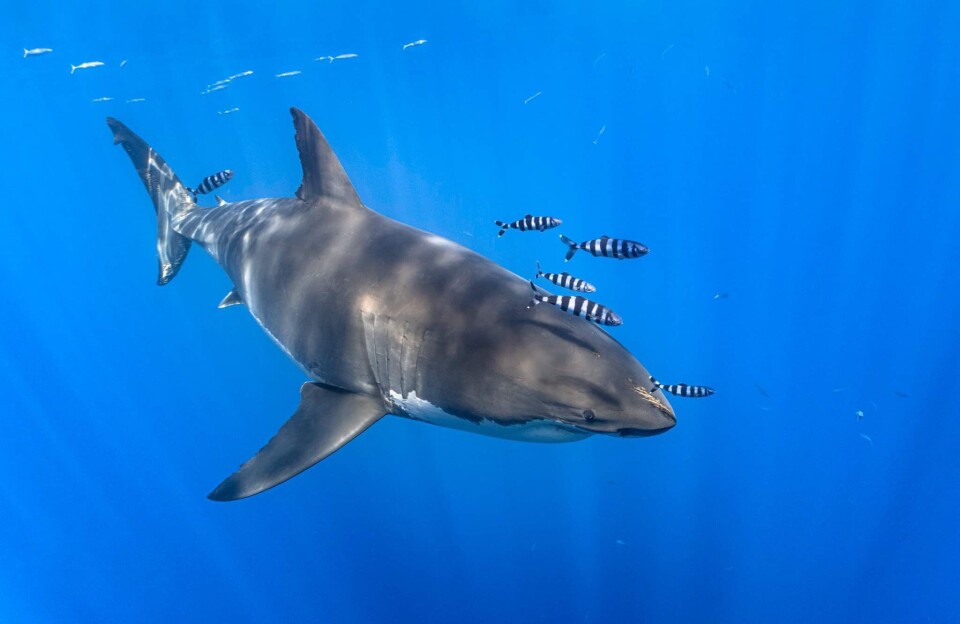THIS CONTENT IS BROUGHT TO YOU BY Nord University - read more

Researchers unveil the genetic history of the great white shark
A new study reveals that around 100,000-200,000 years ago, the great white shark split into three geographically separated populations.
It is one of the planet's most iconic top predators. However, like many other shark species, the great white is classified as vulnerable. In the last 50 years, the number of great white sharks worldwide has nearly halved. In Europe, the species is considered critically endangered.
Researchers at Nord University, in collaboration with an international network and using new approaches, have now mined the genes of the great white shark in unprecedented detail.
Using genetic markers, known as single nucleotide polymorphisms (SNPs), researchers have found that the world's white sharks are distributed as three different populations or lineages which rarely interbreed:
A North Atlantic/Mediterranean population, a population in the southern Pacific Ocean (Indo-Pacific), and a northern Pacific Ocean population.
“Knowledge of genetic diversity is important when it comes to protecting vulnerable and endangered species,” says Professor Galice Hoarau at Nord University.
International collaboration
Together with Professor Leslie Noble, Hoarau leads the research group behind the international collaboration to develop new genetic markers and apply them to white sharks.
These markers can now be used to study genetic diversity and population history in a number of endangered shark species.
As top predators, sharks play an extremely important role in marine ecosystems.
"They are occupy a large space in our imagination, but when it comes to research, there is still much lacking. Especially when it comes to genetics,” he says.
Their new tools and global collaboration have provided the first comprehensive view of white shark population connectivity.

The researchers estimate that the white shark went from being a single population to splitting into three geographically distinct populations between 100,000 and 200,000 years ago.
“This coincides with the penultimate ice age when low sea levels, lower temperatures, and changed ocean currents created new barriers for migrating animal species,” says Catherine S. Jones, lead collaborator from the University of Aberdeen.
She explains that when sea levels and temperatures rose again, great white sharks moved to new habitats further north where they became isolated, perhaps due to changes in ocean currents.
“Placing a timestamp on such a population split is always difficult, and this is a hypothesis where we calibrate divergence - the genetic separation - with the molecular clock. What strengthens our hypothesis is that we have looked at the entire genome,” says Hoarau.
The penultimate ice age, also knwon as the Saale glaciation, lasted from 240,000 to 130,000 years ago.
“Genetic divergence during this period is a pattern we find in a wide range of species, both algae and animals. For example, the same type of divergence has been found in manta rays, around South Africa at the same time,” he says.
New genetic tools
To examine the great white shark's genome, the researchers used a technique called genome-wide target capture.
“What we do is select a set of genes across the entire genome. In total, we're talking about 5,000-6,000 genes. To fish out these genes, we use a bait, which is then attached to small magnetic beads,” explains Hoarau.
Inside these gene sequences, it is possible to find the small variations - SNPs - where a single base pair in the DNA strand is different from that of other individuals' DNA.
“We have analysed tens of thousands of SNPs, which have shown us that there are three completely isolated lineages in the white shark. To be sure those results are correct, we have also sequenced the entire genome of some individuals,” says Noble.
The result is that researchers now have a tool that can be used to study a whole range of other shark species.
The different populations of white sharks are exposed to various dangers, both natural and due to human activity.
“In the Mediterranean, where the population is declining sharply, white sharks are caught as bycatch in fisheries. Also, their natural food, tuna and marine mammals, have declined sharply in the last 50 years, while there is increasing pollution in the coastal areas, where sharks mate and breed,” says Jones.
Around Cape Town, South Africa, and off the coast of California, local population collapses have been observed. These have been believed to be due to attacks by orcas, illegal shark fin trade, and climate change.
Around Australia and South Africa's east coast, efforts to keep sharks away from beaches have led to increased mortality among white sharks.
Changing perspectives on conservation
Hoarau emphasises the need to use genetic knowledge when implementing measures to protect white shark populations.
“We need to know which population we are dealing with, as these are the management units for conservation," says Hoarau.
He explains that if all white sharks belonged to one large, integrated global population, it would not matter so much if they disappeared from one area.
"But if white sharks in, for example, the Mediterranean, constitute a separate genetically distinct population, and this were to be wiped out, we would lose unique genetic diversity. Therefore, we must know the distribution of the different management units and the health of each,” he says.
Noble believes their results necessitate a change in the conservation of great white sharks. Migrating white sharks from genetically isolated lineages may use ocean currents as signposts, keeping to specific areas and maintaining their separation.
Hoarau explains that recent research suggests that climate change is causing changes in several ocean currents, where a tipping point in both the strength and position of ocean currents is expected within less than 50 years.
If these barriers change, populations may begin to interbreed more frequently. However, the researchers' findings suggest that the offspring may not be viable.
“Add that to other challenges, and without refocused conservation management, the outlook for this apex predator and their ecosystems looks less than promising,” he concludes.
Reference:
Wagner et al. Genome analysis reveals three distinct lineages of the cosmopolitan white shark, Current Biology, vol. 34, 2024. DOI: 10.1016/j.cub.2024.06.076

This content is paid for and presented by Nord University
This content is created by Nord University's communication staff, who use this platform to communicate science and share results from research with the public. Nord University is one of more than 80 owners of ScienceNorway.no. Read more here.
More content from Nord University:
-
Kateryna's university has been bombed three times – but she's still teaching
-
5 things you didn't know about smart cities in the Arctic
-
AI sparked an idea that could improve road safety in Norway
-
These algae have been adapting for hundreds of millions of years
-
Could traces of bacteria in water combat salmon disease?
-
Bladderwrack in animal feed has the potential to reduce methane emissions




































